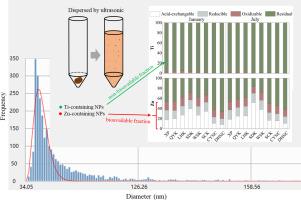Science of the Total Environment ( IF 8.2 ) Pub Date : 2020-09-18 , DOI: 10.1016/j.scitotenv.2020.142388 Feiyun Tou , Jiayuan Wu , Jiquan Fu , Zuoshun Niu , Min Liu , Yi Yang

|
Understanding the behavior and risk of nanoparticles (NPs) in the aquatic environment is currently limited by the lack of quantitative characterization of NPs in the environmental matrices, such as sediments. In this study, based on the single particle (SP)-ICP-MS technique, metal-containing NPs, including Ti- and Zn-containing NPs, were analyzed in sediments taken along the Yangtze Estuary. Combined with the traditional sequential extraction method that has been widely used for metal risk assessment, different single extraction methods were used to understand the association of NPs with different chemical fractions in sediments and their potential environmental implications. Ti-containing NPs, with an average size of 81 nm, ranged from 3.02 × 107 parts/mg to 9.61 × 107 parts/mg, and Zn-containing NPs, with an average size of 41 nm, ranged from 2.47 × 106 parts/mg to 1.21 × 107 parts/mg. Both correlation and redundancy analyses showed that particle concentrations of Ti-containing NPs in sediment were significantly correlated to the Ti-containing NPs in the residual fraction and salinity, indicating that Ti-containing NPs in sediments may be dominated by Ti-containing NPs in the residue fractions of sediments. Large amounts of these NPs may be released from the residual fraction that has been considered to be not bioavailable and “environmentally safe” in the traditional environmental risk assessment of metals in sediments. Zn-containing NPs, mostly associated with carbonates, were positively correlated to all the bioavailable fractions of Zn in sediments, suggesting that these NPs may be largely presented in the bioavailable fraction. This study showed that, vast numbers of NPs with minute sizes were present in estuarine sediments, and that they were associated with different chemical fractions with different potential environmental risks. The study findings call for further research to update the traditional risk assessment method.
中文翻译:

河口沉积物中含钛和锌的纳米粒子:发生及其对环境的影响
目前对水生环境中纳米颗粒(NPs)的行为和风险的了解受到限制,因为缺乏环境基质(如沉积物)中NPs的定量表征。在这项研究中,基于单颗粒(SP)-ICP-MS技术,对沿长江口采集的沉积物中的含金属NP(包括含Ti和Zn的NP)进行了分析。结合已广泛用于金属风险评估的传统顺序提取方法,使用不同的单一提取方法来了解NP与沉积物中不同化学成分的关联及其潜在的环境影响。含钛NP的平均大小为81 nm,范围从3.02×10 7份/毫克到9.61×10 7份/毫克和含锌纳米颗粒,平均尺寸为41 nm,范围为2.47×10 6份/毫克至1.21×10 7份/毫克 相关性和冗余度分析均表明,沉积物中含Ti NPs的颗粒浓度与残留分数和盐度中的含Ti NPs显着相关,这表明沉积物中含Ti NPs可能以沉积物中含Ti NPs为主。沉积物的残留分数。在传统的沉积物中金属环境风险评估中,被认为是不可生物利用和“环境安全”的残留部分可能会释放出大量的这些NP。含锌NPs主要与碳酸盐有关,与沉积物中Zn的所有生物可利用组分呈正相关,这表明这些NPs可能主要存在于生物可利用组分中。这项研究表明,河口沉积物中存在大量的微小分子NP,并且它们与具有不同潜在环境风险的不同化学成分有关。研究结果要求进一步研究以更新传统的风险评估方法。











































 京公网安备 11010802027423号
京公网安备 11010802027423号